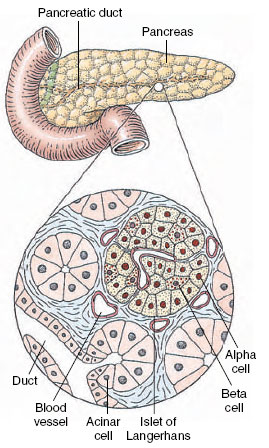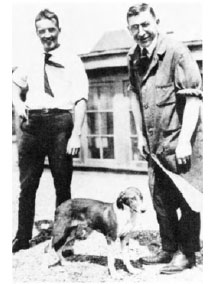Insulin and Glucagon from Islet Cells of the Pancreas
 |
| Figure 36-15 The pancreas is composed of two kinds of glandular tissue: exocrine acinar cells that secrete digestive juices that enter the intestine through the pancreatic duct, and endocrine islets of Langerhans. The islets of Langerhans secrete the hormones insulin and glucagon directly into the blood circulation. |
The pancreas is both an exocrine and an endocrine organ (Figure 36-15). The exocrine portion produces pancreatic juice, a mixture of digestive enzymes and bicarbonate ions conveyed by a duct to the digestive tract . Scattered within the extensive exocrine portion of the pancreas are numerous small islets of tissue, called islets of Langerhans (see Figure 36- 15 and photograph on). This endocrine portion of the pancreas is only 1% to 2% of the total weight of the organ. The islets are without ducts and secrete their hormones directly into blood vessels that extend throughout the pancreas.
Two polypeptide hormones are secreted by different cell types within the islets: insulin, produced by beta cells, and glucagon, produced by alpha cells. Insulin and glucagon have antagonistic actions of great importance in metabolism of carbohydrates and fats. Insulin is essential for uptake of blood-borne glucose by cells, especially skeletal muscle cells. Insulin promotes entry of glucose into body cells through its action on a glucose transporter molecule found in cell membranes. An important exception to this dependency on insulin for cellular glucose uptake are neurons, which do not require the presence of insulin for glucose uptake. This independence from insulin is very important because unlike other cells of the body, neurons almost exclusively use glucose as an energy source. Cells of the rest of the body, however, require insulin to use glucose; without insulin the level of glucose in the blood rises to abnormally high levels, a condition called hyperglycemia. When this level exceeds the transport maximum of the kidney (see note on) sugar (glucose) appears in the urine. Insulin deficiency also inhibits uptake of amino acids by skeletal muscle, and fats and muscle are broken down to provide energy. Body cells starve while the urine abounds in the very substance the body craves. The disease, called diabetes mellitus, afflicts nearly 5% of the human population in varying degrees of severity. If left untreated, it can lead to severe damage to kidneys, eyes, and blood vessels, and it can greatly shorten life expectancy.
In 1982, insulin became the first hormone produced by genetic engineering (recombinant DNA technology,) to be marketed for human use. Recombinant insulin has the exact structure of human insulin and therefore will not stimulate an immune response, which has often been a problem for diabetics receiving insulin purified from pig or cow pancreas.
 |
| Figure 36-16 Charles H. Best and Sir Frederick Banting in 1921 with the first dog to be kept alive by insulin. |
The first extraction of insulin in 1921 by two Canadians, Frederick Banting and Charles Best, was one of the most dramatic and important events in the history of medicine. Many years earlier two German scientists, J. Von Mering and O. Minkowski, discovered that surgical removal of the pancreas of dogs invariably caused severe symptoms of diabetes, resulting in the animal’s death within a few weeks. Many attempts were made to isolate the diabetes preventive factor, but all failed because powerful protein-splitting digestive enzymes in the exocrine portion of the pancreas destroyed the hormone during extraction procedures. Following a hunch, Banting, in collaboration with Best and his physiology professor J. J. R. Macleod, tied off the pancreatic ducts of several dogs. This caused the exocrine portion of the gland with its hormonedestroying enzyme to degenerate, but left the islets’ tissues healthy long enough for Banting and Best to extract insulin successfully from these glands. Injected into another dog, the insulin immediately lowered the level of sugar in the blood (Figure 36-16). Their experiment paved the way for commercial extraction of insulin from slaughterhouse animals. It meant that millions of people with diabetes, previously doomed to invalidism or death, could look forward to more normal lives. Glucagon, the second hormone of the pancreas, has several effects on carbohydrate and fat metabolism that are opposite to the effects of insulin. For example, glucagon raises the blood glucose level (by converting liver glycogen to glucose), whereas insulin lowers blood glucose. Glucagon and insulin do not have the same effects in all vertebrates, and in some, glucagon is lacking altogether. Glucagon is an example of a hormone that operates through the cyclic AMP second-messenger system.




